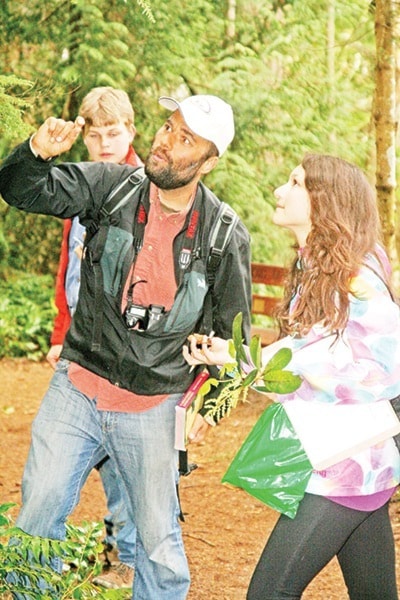A blended learning model that combines homeschooling and classroom learning is growing in both scope and popularity in the district, and may prove to be the new face of education.
"This is where education is going to go in the future," said Sarah-Jane Granholm, middle school program co-ordinator and teacher with the Collaborative Education Alternative Program (CEAP). "It's already there in a lot of places around the world."
Granholm and teacher Jergus Priboj created CEAP's new middle school program for Grades 7 to 9, which began last September. It's known as a flipped classroom in educational language, and involves students doing their foundational work in a home setting and their hands-on work at school. Students do about 50 per cent of their work at school or with teachers or mentors.
The program is sustainability-based and involves growing food in an organic garden, collecting plant samples from forests and gardens, listening to guest speakers from the community, going on educational field trips and working on projects.
The students don't spend long hours in a classroom and they don't stress out about tests. If they do poorly on a test or quiz they can retake it as many times as they like.
And the big difference between CEAP and traditional school is that students and parents create their own schedules. Students can even get credit for the work they are doing outside of school, if it translates to prescribed learning outcomes (PLO) set by the Ministry of Education.
For instance someone heavily into horseback riding may log about their training, and outline steps for improvement, and this may meet their English PLO for the year.
"I've literally had parents leave in tears, so happy to say, finally what my child is doing in real life is going to get recognized as learning," said Granholm.
Colette Schilberg has two children in CEAP's middle school program. Her son has epilepsy and was having a hard time in traditional school. There was too much noise and commotion and he was struggling, she said. Halfway through Grade 8 last year he decided to try CEAP. Schilberg's daughter, who dances 18 to 20 hours a week, saw how well her brother was doing in CEAP and asked if she could also try the program. Schilberg said the results for both kids were shocking.
"They're actually learning more now," she said. "I'm just like wow right, because I was never a parent that thought I would homeschool."
Granholm said the CEAP program makes a lot of sense for students like this. Students who are heavily involved in sports are still expected to take a physical education course, which doesn't make a lot of sense, she said.
At the beginning of the school year there were 8-10 kids enrolled in CEAP's middle school program and by the end of the year they will have about 30. In this small, personalized learning environment the kids are thriving, Granholm said.
Students who were identified as having a learning disability in traditional school have now lost that label, Granholm explained. They no longer need extra time for tests or assignments because they have a personalized plan that is working for them. And the issue of bullying is non-existent, she said.
"We see students that have not believed in themselves as learners before and all of a sudden become these fabulous learners."
CEAP's principal Jeff Temple said he feels CEAP is current and the program understands how children learn in the 21st century. The model offers flexibility and choices, he said.
"It isn't about filling yourself up with a bunch of information, it's about problem solving and critical thinking," he said.
The program is not for everyone, Temple said, as some kids are better suited to learning in a classroom. And some of CEAP's programs involve quite a bit more parent involvement than traditional school.
Besides the middle school program CEAP has a Kindergarten to Grade 6 program, a secondary program, an adult program and a number of other programs that work collaboratively with schools in the district.
In 2007 there were 186 people enrolled with CEAP and in 2012 there were 808.
Granholm said she thinks in the future all schools will become more blended. She said the current traditional system does work for some students but it doesn't work for many others. She repeated an analogy she heard while taking her masters degree in education.
"If you got a teacher and a doctor from a 100 years ago and you beamed them into today, a doctor wouldn't know where they were and a teacher would be right at home," she said. "And there's an inherent problem in that."
The public is invited to learn more about the CEAP program at a special meeting on district programs May 8 at 7 p.m. at KSS' Mutlipurpose room.
For more on CEAP visit www.sd69.bc.ca/school/CEAP.
